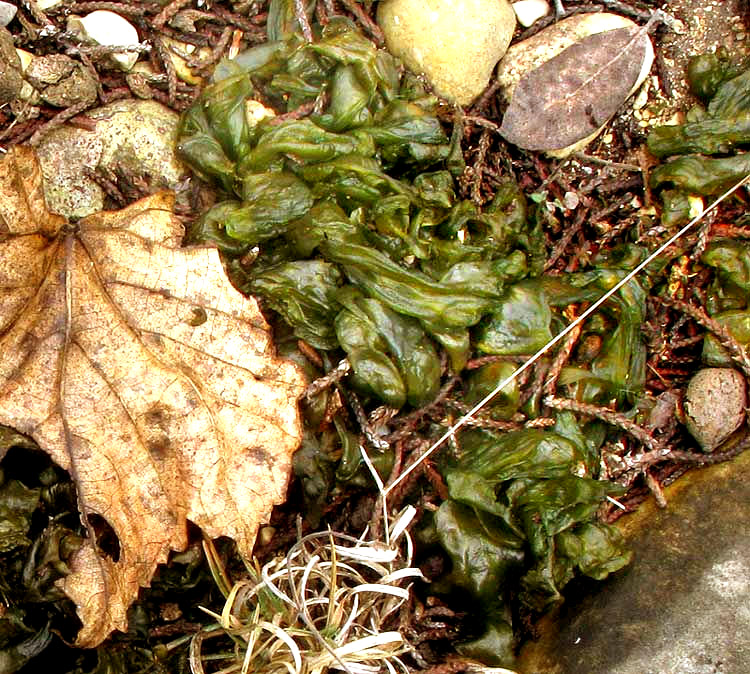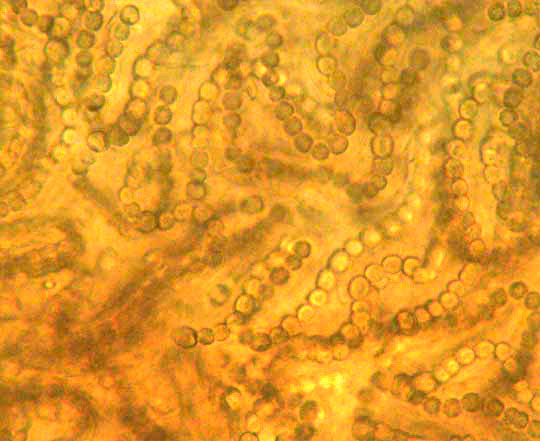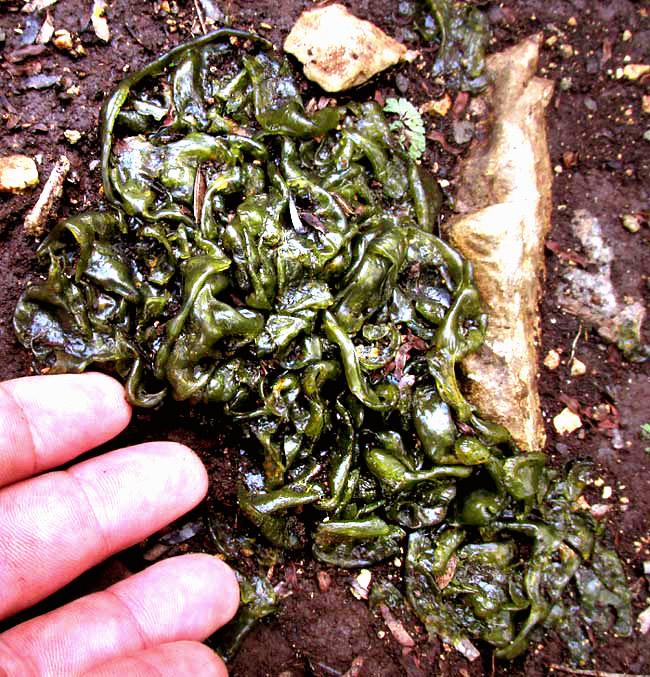Excerpts from Jim Conrad's
Naturalist Newsletter

from the December 23, 2012 Newsletter issued from the valley of the Dry Frio River in northern Uvalde County, southwestern Texas, on the southern border of the Edwards Plateau; elevation ~1750m (~5750 ft); N29.62°, W99.86°; USA
WITCH'S BUTTER
Periodically I walk across the field of cobbles forming a low terrace just above the little Dry Frio River running behind the cabin. I like that area because it's an extreme environment -- one where soil can't form atop the cobbles, where even Ashe Junipers have trouble taking root -- so it's a good place to find organisms unusual for this area, and with unique adaptations. For example, our impressive, agave-like Sotols grow best in these cobble fields, as well as the knee-high agave called Lechuguilla, which is abundant in the vast Chihuahua Desert to our west in Mexico, but which until now, here, I've found only in these cobble fields.
So, in an open area in this field of cobbles with Lechuguillas and Sotols growing all around, on certain areas of packed sand I found bunches of dark green, gelatinous stuff looking like freeze-damaged lettuce, as shown at the top of this page.
My first thought was that it was some kind of green, photosynthetic jelly fungus, but I couldn't remember anything like that. Then I thought it was some kind of herb killed by our recent freeze, but this thing covered the ground over a very large area, and I knew that just a week ago there'd been no herb there, and none of this green, squishy, stuff, either.
Slowly my brain crunched the data and with a little computering the mystery revealed its identity.
It's a kind of photosynthetic bacterium -- a cyanobacterium. It's NOSTOC COMMUNE, going by such evocative English names as Witch's Butter, Star Jelly and Mare's Eggs. It's found nearly worldwide, though only in certain habitats. The Wikipedia page says that it's "able to survive in extreme conditions in polar regions and arid areas. It is a terrestrial or freshwater species and forms loose clumps on soil, gravel and paved surfaces, among mosses and between cobbles." And between cobbles in an arid area is exactly what we have.
In Plant Kingdom class in college back in the early 1970s we were taught that Nostoc was a blue-green alga. One reason that Witch's Butter is no longer considered to be an alga is that its cells contain no nuclei or internal membrane systems. Instead of undergoing standard mitosis, the cells simply divide into two with none of that chromosome-lining-up business going on in the dividing cells of higher organisms. Also, Nostoc's photosynthesizing pigments are scattered loose in the cells' cytoplasm, not organized into chloroplasts as among the algae. One reason Nostoc can survive in our sun-baked cobble field is that it also contains pigments that absorb long- and medium-wavelength ultraviolet radiation.
Not only can Nostoc photosynthesize, but also it can "fix" atmospheric nitrogen -- convert the abundant but mostly unusable nitrogen in our air into forms absolutely necessary for itself and other organisms.
I read that Witch's Butter is eaten in many countries. In China it's known as "Facai" and a dish made from it is traditionally served at the Lunar New Year.
This is the second cyanobacterium we've run into here, the other being a filamentous species known as Oscillatoria, and I'm getting the feeling that I need to start paying more attention to this group.
In the book Oceans and human health: risks and remedies from the seas, I Steward and IR Falconer write that in the history or Life on Earth, cyanobacteria created the conditions in the Earth's early atmosphere that directed the evolution of the higher oxygen-using organisms that came after them, and that currently they are very important contributors to the planetary biosphere's carbon and nitrogen budgets.
That's saying a lot for a group of organisms that during my years in college wasn't even recognized as other than just a group of primitive algae.
from the February 16, 2014 Newsletter issued from the Frio Canyon Nature Education Center in the valley of the Dry Frio River in northern Uvalde County, southwestern Texas, on the southern border of the Edwards Plateau; elevation ~1750m (~5750 ft); N29.62°, W99.86°; USA
NOSTOC UNDER THE MICROSCOPE
Textbooks often show Nostoc cells, which look like long, twisting strands of beads that don't look the least like our Witch's Butter. I've never reconciled the appearance of Witch's Butter with those snaky filaments, so this week when I found some littering very thin soil atop our limestone hill I took a sample and back at Juniper House looked at a thin sheet of it beneath the microscope. At lower magnifications all I saw was brown, jelly-like stuff, but finally at the highest power I saw what's shown below:

So, the gelatinous material we call Witch's Butter is mostly mucilage in which long, curving filaments of connected cells are embedded. I read that Nostoc colonies take on a variety of macroscopic appearances, depending on the species. Some look smooth or warty, or loose or dense, spherical, flat, gelatinous, or maybe just as irregular-shaped mats.
from the November 29, 2015 Newsletter issued from Hacienda Chichen Resort beside Chichén Itzá Ruins, central Yucatán, MÉXICO
NOSTOC AMONG THE MAYA
Here at the end of the rainy season, on wet ground in shady spots, sometimes you find the mysterious-looking organism shown below:

In Texas we found what looks like the same thing, similarly on ground that during most of the year was hard, hot and very dry, but which for brief periods became sodden with rainwater, and identified that organism as Nostoc commune. To see if the Maya could add anything to what we learned about Nostoc in Texas, I went to my Maya friend Paulino and asked what the Maya think about it.
Paulino told me that in Maya Nostoc is called Táak-chak, which sort of embarrassed him, since the name means "rain-poop," chak being the word for rain and táak referring to excrement. In Maya, when a word has "áa" in it, it means that there's a sort of hitch or hard stop after the first a, and that the a sound is pronounced longer than in words with only one a.
Paulino told me that medicinally Táak-chak is important to the Maya. We've spoken before about the powerful influence in this culture of the ojo malo or evil eye. If a drunk or someone who's worked all day under the sun building up energy in his body, or maybe a curandero (witch doctor) with bad intentions, looks at anyone the wrong way, especially a baby or young person, it'll make that person sick, and a curandero has to undo the damage.
Táak-chak isn't for that kind of evil eye, but rather it's for a similar kind of evil eye the rain has, and the rain's eye can do evil-eye stuff to babies. To cure chak-ojo, or rain-eye, you soak Táak-chak in a baby's wash water, and when the organism's influences are soaked into the water, wash the baby with it.
I started to tell Paulino how important cyanobacteria such as Nostoc are, but before I could get into its evolutionary effect on Life on Earth, he'd already agreed that it was very important, but he was thinking of washing little Maya babies with it, when they got the chak-ojo.